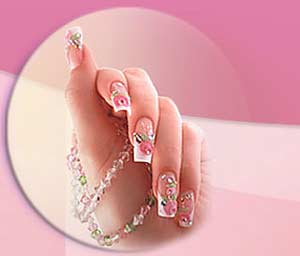The use of nail polish and artificial nails can have adverse effects on women’s health. Harmful chemicals such as acetone, benzene, and toluene pose a high risk of allergic reactions and infections.
The primary functions of fingernails and toenails go beyond mere aesthetics; they also play a crucial role in physiology, enhancing tactile function and fine motor skills. The application of nail polish, removal chemicals, and other related products can be dangerous for nail health due to the presence of toxic substances.
 |
| The use of nail polish and artificial nails adversely affects women’s health (Image: erica-nail) |
Nail products commonly used include whitening agents, hardeners, nail removers, old polish removers, nail polish, and topcoats. The first three types are less toxic, while the latter are more volatile and pose greater risks. Additionally, substances used for removing artificial nails often contain acetonitrile or methyl cyanide, which can trigger allergic reactions and irritate users.
Most chemicals used in nail care are approved by the U.S. Food and Drug Administration (FDA). However, in many countries, regulations remain lax, leading to unforeseen harmful effects.
Benzene, an excellent solvent found in nail polish removers, is one of the organic solvents that can be toxic to users and nail technicians. This substance evaporates quickly and is absorbed through the respiratory system, where it accumulates in the liver, spinal cord, and fat cells.
The bone marrow is particularly susceptible to the toxic effects of benzene, hindering cell growth and regeneration. Benzene exposure can cause neurological toxicity, leading to symptoms such as dizziness, fatigue, and confusion. Continuous inhalation over a long period may result in a deficiency of red blood cells, white blood cells, and platelets. Acute lymphoblastic leukemia and non-Hodgkin lymphoma may develop 10-15 years later.
Acetone, an important solvent in nail polish removers, causes nails to become brittle and damaged, leading to irritation on the skin of fingers and toes. Inhaling large amounts of this volatile substance can be very harmful to the lungs, causing dizziness and loss of balance. Toluene also poses risks as it is increasingly being used as a substitute for benzene. This substance can be addictive if inhaled excessively.
Toluene is poorly soluble in water and quickly distributes to brain, liver, and kidney tissues after inhalation. It directly affects the nervous system, particularly in pregnant women. During nail procedures, if the cuticle is cut or detached, infection-causing agents can enter through non-sterilized tools.
Although methyl methacrylate in nail products has been banned and replaced with chemicals like ethyl methacrylate, the FDA still warns that these replacements can be harmful. Common complications from the use of artificial nails include bacterial and fungal infections.
The problem arises when artificial nails thin and lift the natural nails, creating gaps for dirt to accumulate. Acrylic substances can cause redness, swelling, and pain in the nail bed. This environment allows bacteria and fungi to proliferate on the natural nails. If the area around the damaged nails is not regularly cleaned, infections can worsen, potentially leading to finger necrosis. In many cases, if the nail is lost, regrowth may not restore it to its original state.
Enhancing the appearance of fingernails and toenails is not inherently wrong, but it can seriously impact health if precautions are not taken. To avoid unfortunate complications, it is essential to adhere to guidelines: read and follow instructions carefully, use only products specifically designed for nails from reputable sources, and avoid wearing artificial nails continuously for extended periods. If symptoms such as swelling, redness, or infection around the nails occur, seek medical attention for disinfection and infection control.


















































